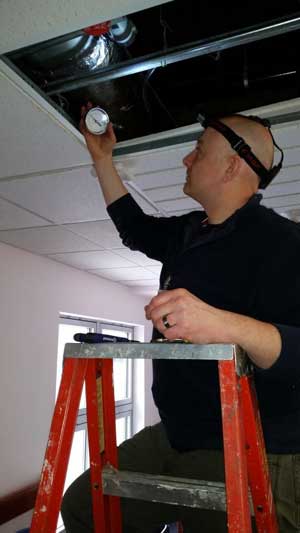Pre-Functional testing is a vital step in the commissioning process, where issues can be identified and corrected during equipment installation. It is important to catch issues at this phase in the construction process as issues are often able to be resolved faster, easier and cheaper than if they were identified after construction is complete. Some of the equipment checks may seem a bit obvious and somewhat redundant, but we verify them on every commissioned project—and you might be surprised to learn how often these basic checks uncover deficiencies.
Equipment Make and Model
In this step we verify the make and model of the equipment installed, using the approved  submittal for construction. This may seem like a detail that is hard to mess up, but errors on this item happen for different reasons. Sometimes it can be because the wrong piece of equipment was shipped from the factory, sometimes the wrong equipment was ordered, and in some extreme cases we have even seen instances where the wrong label was put on the piece of equipment at the factory. Another situation where this step is important is when you have multiple pieces of similar types of terminal equipment such as fan coils or VAV boxes. There can easily be over 100 VAV boxes in a building, and there may be five different sizes. This can result in a mix up where, for example, a six inch VAV box ends up in the place where an eight inch VAV was to be installed.
submittal for construction. This may seem like a detail that is hard to mess up, but errors on this item happen for different reasons. Sometimes it can be because the wrong piece of equipment was shipped from the factory, sometimes the wrong equipment was ordered, and in some extreme cases we have even seen instances where the wrong label was put on the piece of equipment at the factory. Another situation where this step is important is when you have multiple pieces of similar types of terminal equipment such as fan coils or VAV boxes. There can easily be over 100 VAV boxes in a building, and there may be five different sizes. This can result in a mix up where, for example, a six inch VAV box ends up in the place where an eight inch VAV was to be installed.
It is imperative that these basic details are verified since they can have a large effect of performance of a building or building space.
Equipment MOCP and Breaker or Fuse Size
Maximum Over-Current Protection (MOCP) is normally listed on equipment nameplates and indicated on the approved construction submittals for the equipment. The MOCP refers to the size of the over-current protection device (breaker or fuse) that needs to be used for that piece of equipment. It is important for the installed protection device size to be correct to ensure the equipment performs reliably and safely. A protection device that is too small could cause the breaker to trip excessively preventing the equipment from running as designed. A protection device that is too big could pose safety concerns as more amperage would be allowed to pass through the equipment and wiring than designed.
Electric Motor Efficiency
Electrical motors are used everywhere in commercial HVAC building systems, and it's important to verify that installed motors that are one horse power and above match the design intent and the local building code. A motor installed that does not meet minimum efficiency specified by the design can result in the building owner seeing higher electrical power consumption. In some situations equipment, like a rooftop unit for example, may be accidentally shipped with fan motors that do not meet the local building code minimum efficiency requirements.
Conclusion
These are a few examples of common pre-functional testing checks that are made on every commissioning project. Every project is different and project specific checks are always made as needed to ensure equipment is installed correctly and ready for startup. If this step of the commissioning process is completed thoroughly during construction, escalations in project cost, negative schedule impacts, and other headaches can be avoided.


